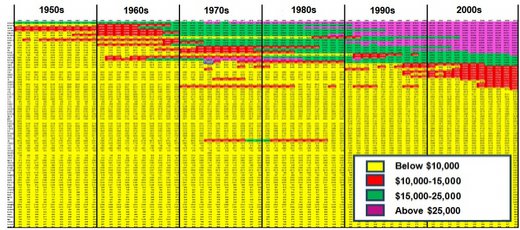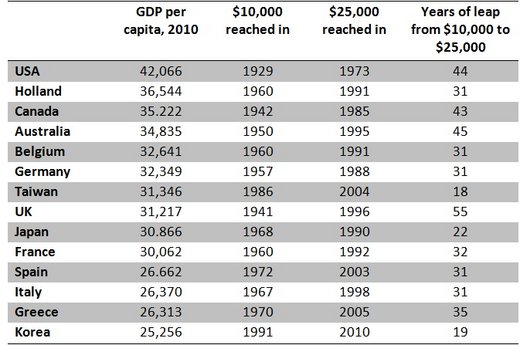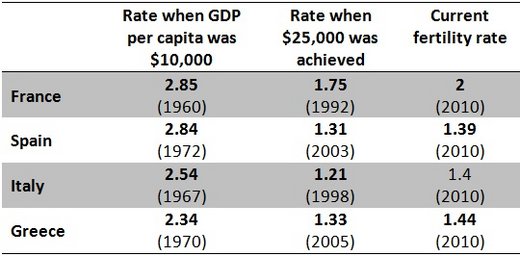TEPAV Articles
- [Archive]
$25,000 GDP per capita in 2023: Are we dreaming? 04/06/2012 - Viewed 4645 times
Turkey’s GDP per capita reached $10,000 in 2011, finally surpassing the five-digit threshold. The next goal is to reach $25,000 by 2023.[1] We have 11 years to go. Can we really make it?
Please check the chart below to see where we are currently. The chart shows GDP per capita in countries with populations over 10 million (that is 84 countries[2]) for the last six decades. The data is difficult to examine, as there are 5160 different cells in the figure. Each row represents a country and each column represents a year. Yellow cells indicate that the GDP per capita of a country in the corresponding year was below $10,000. Red cells indicate a GDP per capita between $10,000 and $15,000, while green cells mark per capita income between $15,000 and $25,000. Countries in the pink are best positioned, with a GDP per capita above $25,000. So, what does the figure show us?
- Among countries with populations above 10 million, only 14 have a GDP per capita above $25,000. All but the US on top, and Canada in the third row reached this level after the 1990s.
- Turkey earned its demarcation only in 2011. In the 11 years ahead, we seek first to upgrade to green with $15,000 and then to the league of pink with $25,000 GDP per capita.
Figure 1: GDP per capita in 84 countries with populations above 10 million between 1950 and 2010, PPP, 2005 prices (ranking based on 2010 figures)[3]

Source: www.gapminder.org
Nothing is impossible. To make it to the pink league however, we better skip the boring estimates on the growth rate and look at how long it took for other countries to reach $25,000. The table below shows how many years it took the 14 leading countries to leap from $10,000 (the current level of per capita income in Turkey) to $25,000 (the target for 2023).
Table 1: GDP per capita of countries with populations above 10 million and GDP per capita above $25,000 and years when GDP per capita reached $10,000 and $25,000

Source: www.gapminder.org
Here are some hot facts:
- On average, it took 33 years to make the leap from $10,000 to $25,000 per capita income. In other words, in order to reach its target by 2023, Turkey has to run three times as fast as the 14 countries in the pink league.
- There are only 3 Asian countries on the list: Japan, Taiwan, and Korea. These made the leap in 20 years on average. Korea moved from $10,000 to $25,000 in 19 years, by 2010. The country is about two decades ahead of Turkey.
- There are 4 Mediterranean countries on the list: France, Spain, Italy, and Greece. Despite all the support from the European Union, these took 32 years to go pink. So even if Turkey performs as well as its fellow Mediterraneans, it will not be reaching $25,000 per capita income by the time I am 43 (in 2023), but when I am 64, and already retired (in 2044, inşallah).
This is not going to be easy. Each moment of the eleven years until 2023 is precious. We have to view every development as something that could potentially move us closer to our 2023 target. But how? Let me cite from a popular debate of this week.
The following table shows fertility rates (the average number of children born to each woman) in the 4 Mediterranean countries that have achieved $25,000 per capita income.
- As the countries upgraded from $10,000 to $25,000, the average number of children per woman decreased almost by 50 percent, from 2.6 to 1.4.
- More remarkably, the fertility rate started to increase after the country reached $25,000 per capita. French women, for instance, had almost as many children as Turkish women in 2010, despite the low fertility rate in the 1990s.
Table 2: Fertility rates in Mediterranean countries with a GDP per capita above $25,000 (rate when GDP per capita was $10,000, when $25,000 was achieved and current rate)

Source: World Bank, World Development Indicators
Consider the effect the banning abortion, as has been debated recently, would have on the $25,000 GDP per capita target. In the years ahead, prosperity will increase fertility rates. Women are willing to have more children in all OECD countries but Turkey. Fertility rates in rich countries are on the rise. The chief factor here is the increasing quality and access healthcare for children and the elderly.[4] Turkey must learn from the experience of Mediterranean and OECD countries that have increased fertility rates while becoming more prosperous.
Concerning the $25,000 GDP per capita target, both the “three children per family” motto as well as the anti abortion debate are severely problematic. We risk losing the target if we don’t start to handle our issues differently soon.
[1] I have written two commentaries on this issue: (1) Does the AKP’s Plan for 2023 ensure 8.48 percent annual growth? http://www.tepav.org.tr/en/kose-yazisi-tepav/s/2403; (2) Being a top ten economy: Are we dreaming? http://www.tepav.org.tr/en/kose-yazisi-tepav/s/2842
[2] I exclude countries with populations below 10 million, as comparing Turkey with countries smaller than a single region in Turkey would be inconclusive.
[3] You might be wondering the country at the center. In the yellow zone in the 1970s, it jumped first to the red and then to the green zone in the 1980, then fell back to the yellow zone with $3000 in the 1990s. This misfortunate country is Iraq.
[4] http://www.oecd.org/dataoecd/61/35/47701128.pdf
*Esen Çağlar, TEPAV Economic Policy Analyst, http://www.tepav.org.tr/en/ekibimiz/s/1025/Esen+Caglar














